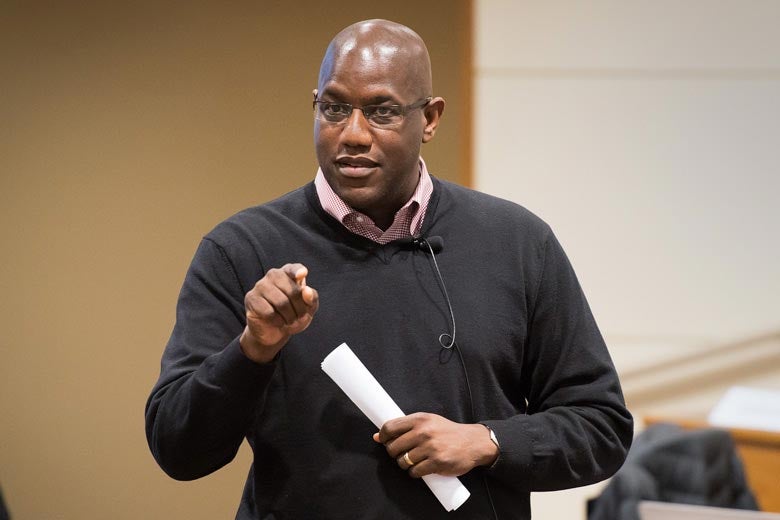
Bernard Muir, director of athletics at Stanford, oversees programs that conserve water and energy on campus. (Image credit: L.A. Cicero)
In a recent conversation, Bernard Muir, the Jaquish & Kenninger Director of Athletics at Stanford, talked about some of the many ways the Department of Athletics, Physical Education, and Recreation (DAPER) is actively contributing to Sustainable Stanford, the university’s campus-wide effort to reduce its environmental impact, preserve resources and show sustainability in action.
The athletics department operates 70 buildings on campus, including sports venues, recreation centers, team facilities, offices for coaching and administrative staff, and rental housing for assistant coaches. Could you give some examples of the steps DAPER has taken in recent years to conserve energy, reduce waste and conserve water?
The department recently completed energy efficiency projects – the installation of new HVAC (heating, ventilation, air conditioning) systems – in five buildings: Maples Pavilion, Avery Aquatic Center, Stanford Stadium, Burnham Pavilion and the Arrillaga Center for Sports and Recreation. Thanks to those projects, we have significantly reduced energy consumption and are now paying substantially less in energy bills.
We added compost and recycling bins throughout Stanford Stadium, and recycling dumpsters to the stadium’s parking lots. In the stadium’s tailgating areas, we replaced diesel light towers with solar-powered lights. Last season, we recycled nearly 10 tons of material after the first four Stanford Football home games.
We cut water consumption on our fields by 24 percent last year through hand watering, by shutting down sprinkler heads in various areas and by installing field turf – artificial grass – in parts of our landscaping. You’ll see examples of field turf in front of Maples, outside the track facility and Maples Pavilion. As you walk outside our building (Arrillaga Family Sports Center), you’ll see a mound of field turf. During our summer camps, you’ll see kids playing on it.
At Stanford, sustainability is a core value. How does Stanford Athletics approach sustainability?
Every time we host an event, whether it is a practice, a contest, a clinic or a camp, we have the opportunity to demonstrate our department’s commitment to sustainability. Last year, we hosted nearly 500 events on campus. We have an “audience” of millions, including students, athletes, alumni, fans, participants and visitors from around the world.
Collaboration with university partners is key for us. We collaborate with Stanford Residential & Dining Enterprises (R&DE), which runs our concessions and has expertise in sustainable dining practices. To have R&DE as a partner is pretty special and allows us to be very creative in how we approach sustainability issues. We give each other feedback – what worked, what didn’t work, what concerns were raised – and solve problems together.
We also collaborate with Sustainable Stanford, a university-wide effort to reduce our environmental impact, preserve resources and show sustainability in action. Together, we created a Stanford Athletics & Sustainability webpage to highlight our achievements and encourage people to take specific steps to reduce their environmental impact. The Office of Sustainability recently hired an intern, a former student athlete, who is working closely with our events and facilities staff and providing feedback on how we can improve.
Is Stanford Athletics part of a national sports community supporting sustainability?
We have been members of the Green Sports Alliance since 2013. It’s a nonprofit organization whose mission is to help sports teams, venues and leagues enhance their environmental performance. Every team in the Pac-12 Conference is a member. Last summer, the Pac-12 Conference office became an official member of the alliance.
How will Stanford Athletics highlight its sustainability practices during the basketball games in Maples Pavilion on Feb. 11 and Feb. 26?
The games will serve a dual purpose, because we’re competing in the Game Day Basketball Challenge sponsored by RecycleMania, which will compare schools based on recycling and waste minimization efforts, and we’re competing in the Pac-12 Zero Waste Bowl. For each game, Stanford will report the total tonnage sent to landfill vs. recycled or composted, and compete against other colleges and universities that are also committed to reducing the amount of waste they send to landfills.
At both games, Stanford student volunteers will educate fans at all of the waste stations about how to properly sort waste into recycling and compost bins. They will also collect in-person pledges to support ReycleMania’s mission. During halftime, Stanford will show a 2015 video, “All About No Waste,” a student parody of the hit song “All About That Bass” that showed Stanford students how to recycle and compost. The university is also encouraging fans to donate used athletics shoes for proper reuse/recycling at Maples Pavilion.
The basketball games will be held at 8 p.m. on Feb. 11 (men) and at 8 p.m. on Feb. 26 (women) in Stanford’s Maples Pavilion.
What are some of the key sustainability initiatives you will focus on in coming years?
We will continue expanding our recycling and composting programs. In addition, we will evaluate how we can improve the energy efficiency of the restrooms and locker room in our recreation centers through the use of low-flow toilets and energy-efficient LED (light-emitting diode) lighting. We will install more signs in our recreation centers that encourage the students, faculty and staff who use the facilities to join our sustainability efforts, by outlining the steps they can take to conserve energy and water.
To better control water consumption in our landscaped areas, we will purchase a new irrigation control system. We will finish installing LED lights at Avery Aquatic Center that will save energy during night practices and competitions. We are evaluating the possibility of installing LED lights in Maples Pavilion.